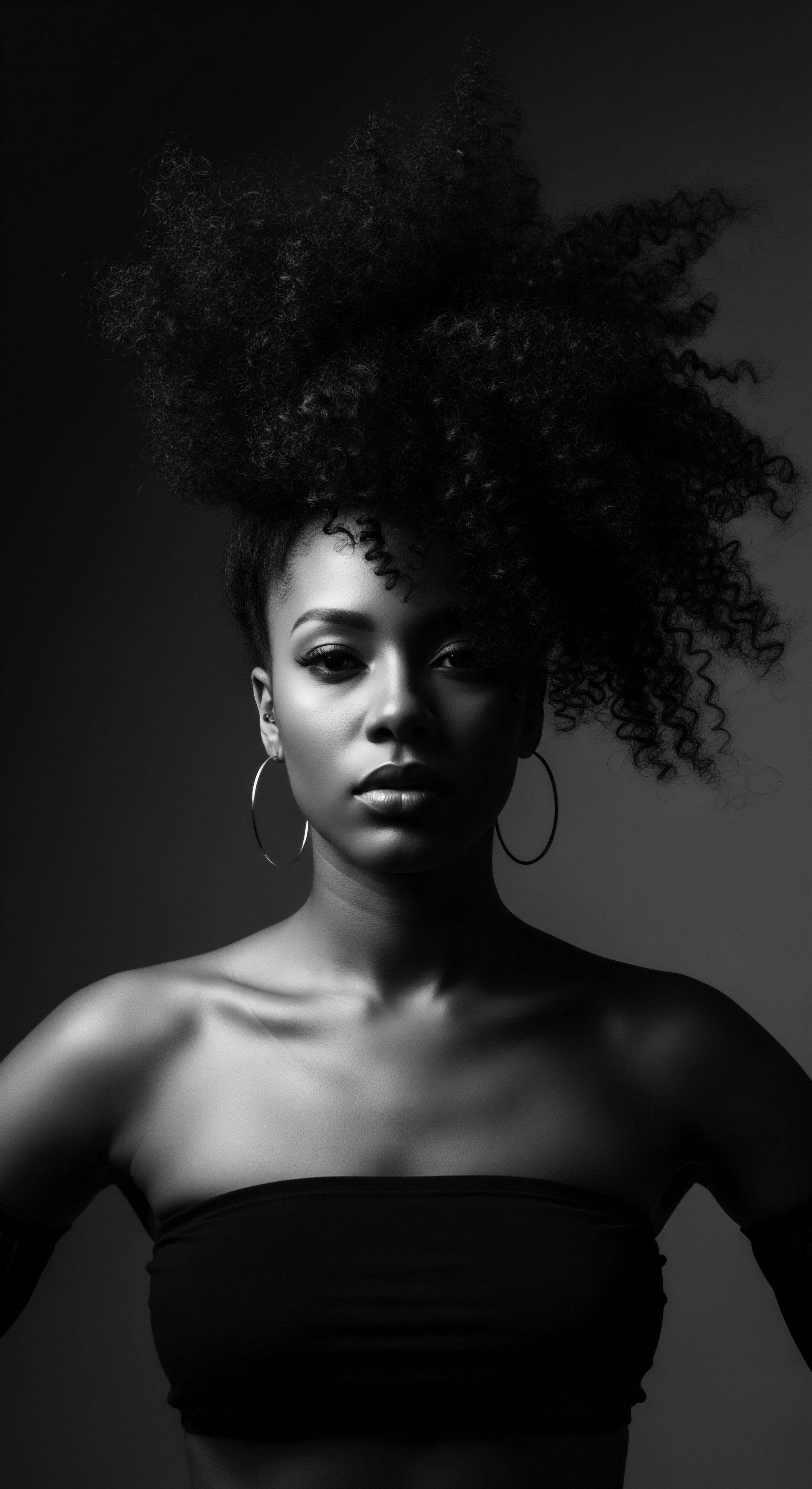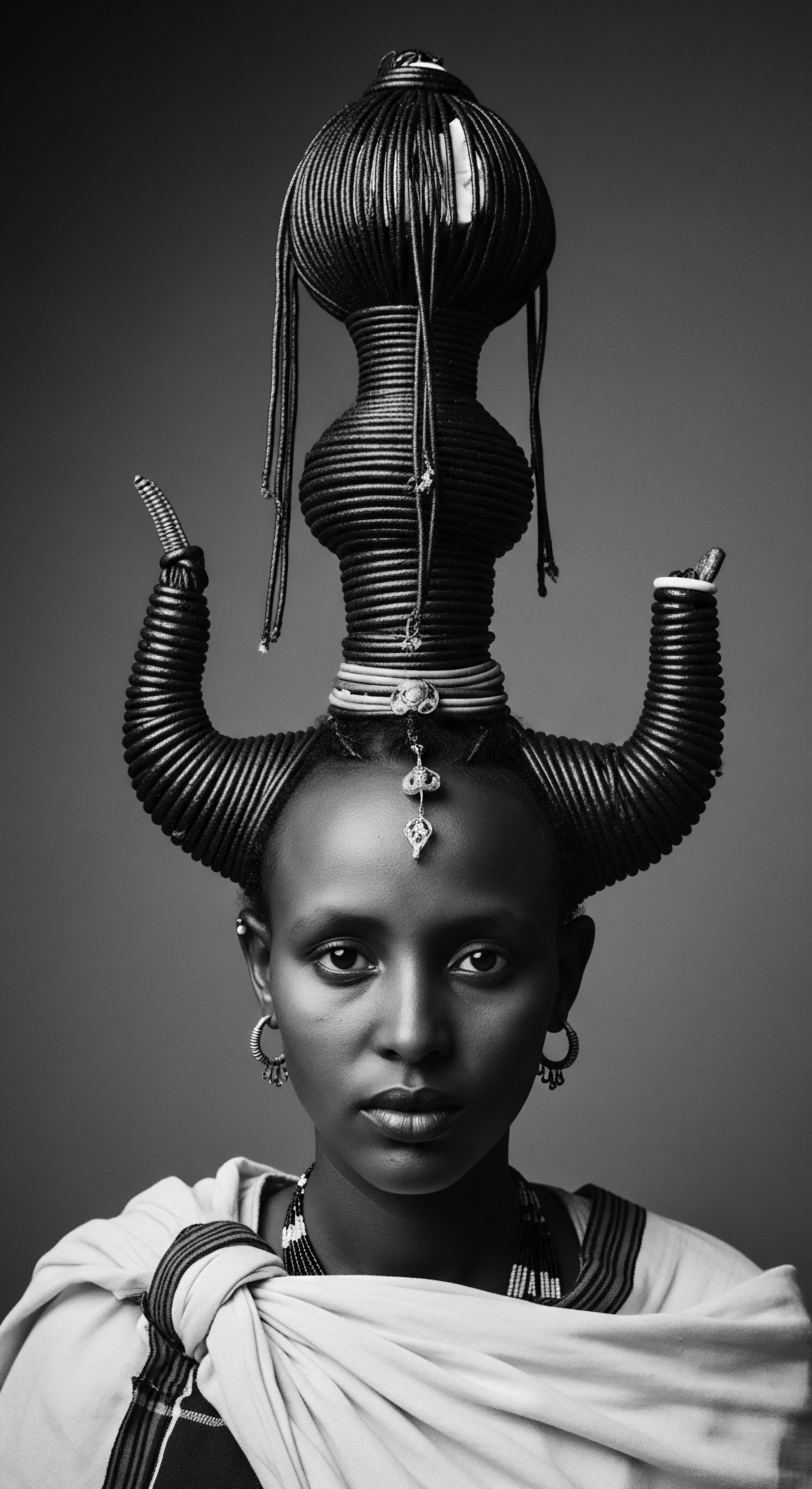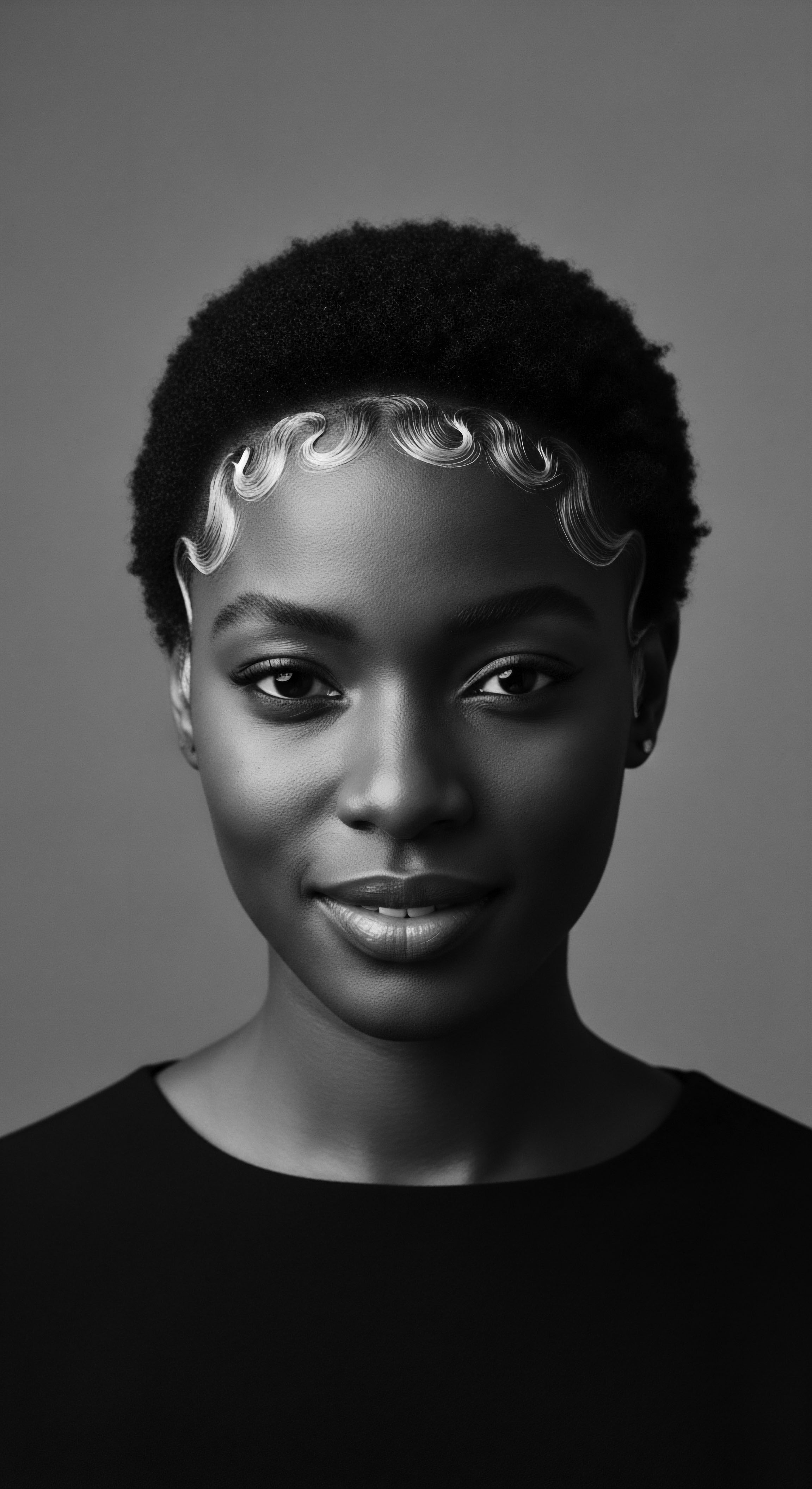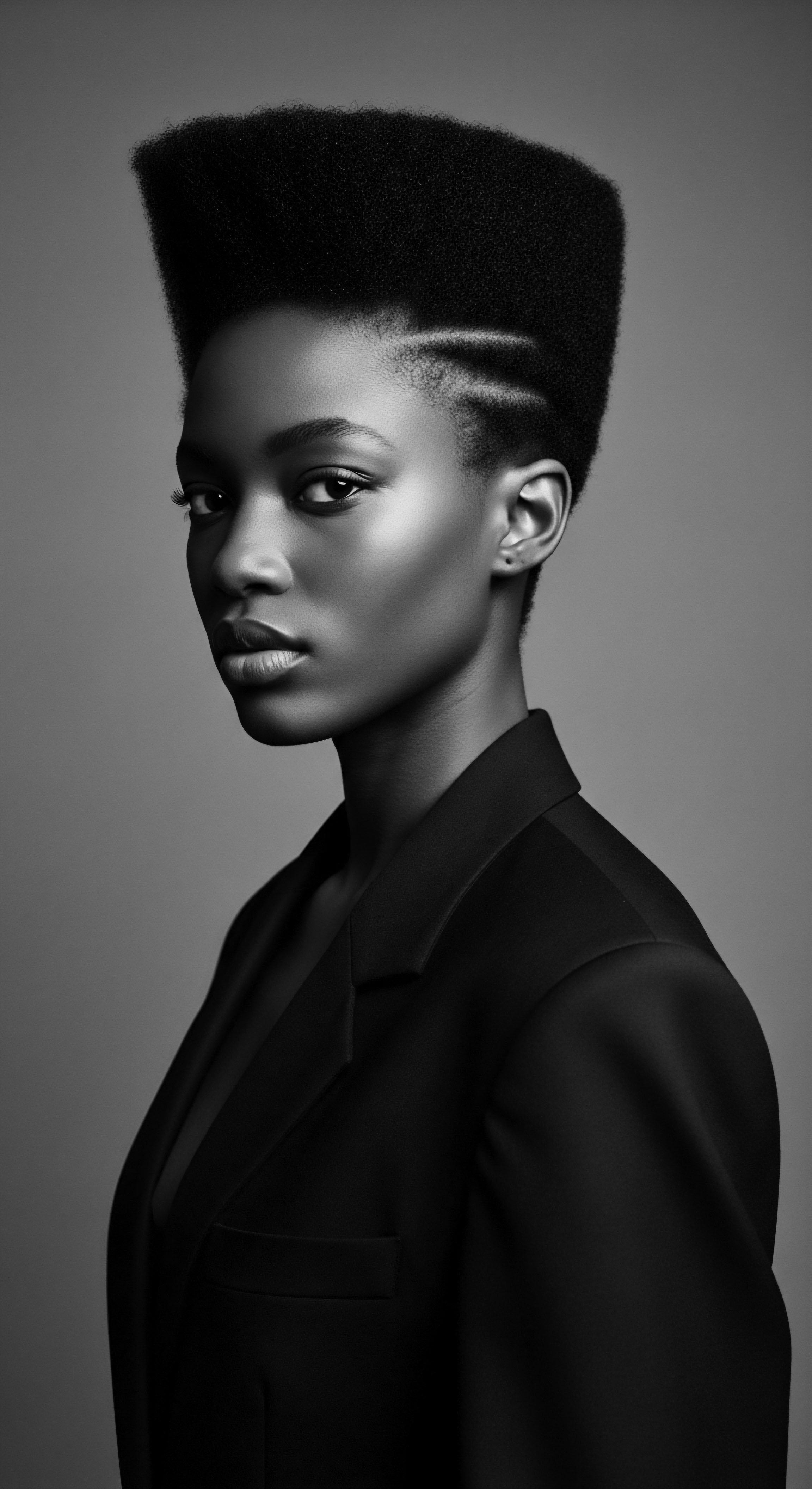
Roots
The very strands upon our heads carry whispers of epochs, of hands that caressed and cultivated, of wisdom passed through generations under sun-drenched skies and starlit nights. For individuals of Black and mixed-race ancestry, hair is never merely a biological filament. It is a living archive, a scroll unrolling tales of survival, artistry, and profound connection to the earth and spirit.
We consider how modern scientific understanding might illuminate the age-old practices of African hair care, revealing the enduring strength within these traditions. This exploration honors the truth held within each curl, coil, and kink, acknowledging its unique heritage as a testament to resilience and an unbroken lineage.
The question before us, whether contemporary science can validate ancestral African hair care practices for strength, invites us to look deeply. It is a dialogue between ancient knowing and modern discovery, a recognition that wisdom did not begin in a laboratory, but in the sustained observation and ingenious application of natural resources by communities across the African continent. We delve into this shared inquiry, allowing the science to speak not with a voice of dismissal, but with a voice of affirmation for practices born of necessity and elevated to ritual.

Understanding Textured Hair Biology
To truly appreciate the strength woven into ancestral African hair care, one must first grasp the inherent characteristics of textured hair. African hair, often described as ulotrichous, displays unique structural properties compared to other hair types. Its cross-section is typically elliptical, not round, and the hair follicle itself is curved, leading to the distinctive coiling patterns. This curvature, while visually stunning, creates points of geometric weakness along the hair shaft, making it more susceptible to breakage than straight hair.
Consider the path a single strand of tightly coiled hair takes from the scalp. It twists and turns, each bend a potential point of fragility where the cuticle, the outer protective layer, might lift or become compromised. This inherent structure also means that natural scalp oils, known as sebum, struggle to travel down the spiraling strand, often resulting in natural dryness.
This physiological reality underpins centuries of traditional care focusing on moisture and gentle handling. Modern science corroborates this need for hydration and care.
Textured hair, with its unique elliptical cross-section and curved follicle, possesses inherent structural properties that inform ancestral care methods.
Melanin Distribution within the hair shaft also plays a part. Eumelanin, the dark pigment, is responsible for the deep hues of Black hair, and its presence can affect the hair’s overall properties. The tight coiling also leads to what is known as “shrinkage,” where the apparent length of the hair is significantly shorter than its actual stretched length. This characteristic is not a flaw, but a natural expression of the hair’s coiled architecture.

Historical Context of Hair Care Needs
The genesis of African hair care practices reaches back millennia, long before colonial encounters reshaped perceptions of beauty. In pre-colonial African societies, hairstyles were far more than simple adornments. They served as a visual language, communicating an individual’s age, marital status, social standing, tribal affiliation, wealth, and even spiritual beliefs. The intricate braiding patterns seen across different ethnic groups were not merely aesthetic choices; they were declarations of identity, deeply embedded in the social fabric.
The methods developed over these long periods responded directly to the hair’s natural characteristics and environmental factors. Dry climates, intense sun exposure, and the need for hygiene in daily life all shaped the communal and individual rituals surrounding hair. The materials used were those readily available from the local environment—plants, natural fats, and minerals. This practical engagement with nature led to a deep understanding of what genuinely sustained hair health.
- Himba of Namibia ❉ Adorned their hair with otjize, a paste of red ochre, butterfat, and aromatic resins, symbolizing their connection to the earth and their ancestors.
- Yoruba of Nigeria ❉ Crafted styles often with profound spiritual significance, with skilled braiders holding respected positions within the community.
- Ancient Egyptians ❉ Used styles that could symbolize fertility, beauty, and even spiritual protection, often incorporating natural fibers.
The forced transatlantic slave trade tragically severed many of these connections, stripping enslaved Africans of their cultural roots, including their hair care practices and tools. Yet, even in the harshest conditions, ingenuity persevered. Enslaved people would braid rice or seeds into their hair for sustenance during escape, and cornrows became concealed maps to freedom. This enduring spirit of adapting, of finding ways to care for one’s hair and identity, speaks volumes about the intrinsic value placed upon textured hair heritage.

Ritual
The hands that shaped ancestral hair care were guided by more than just aesthetics; they followed a rhythm of ritual, a deep understanding that care was communal, intentional, and deeply tied to wellbeing. These practices, often passed down from elder to youth, transcended mere grooming to become expressions of love, identity, and shared cultural knowledge. Today, we begin to decode the principles embedded within these rituals, revealing how modern scientific thought can align with what our ancestors knew by instinct and observation. The strength of textured hair, it seems, is not merely a sum of its proteins, but also a reflection of its care and cultural context.

Why Traditional Practices Align with Hair Biology
Ancestral African hair care practices intuitively addressed the specific biological characteristics of textured hair. The emphasis on moisture, low manipulation, and protection directly combats the inherent dryness and fragility of coily strands. When tightly coiled hair is allowed to air dry and then sealed with rich, natural emollients, moisture is retained within the hair shaft.
This process reduces the likelihood of breakage, a frequent concern for those with textured hair. The practice of “soak and smear,” as it is known in modern dermatological contexts, wherein water-based conditioners are applied to damp hair followed by occlusive oils or butters, directly mirrors ancestral methods of hydration and sealing.
Many traditional African ingredients possessed properties that modern science now attributes to them.
- Shea Butter ❉ A staple across West Africa, shea butter is renowned for its intense moisturizing benefits. Scientific analysis confirms its rich composition of fatty acids and vitamins A and E, which provide a protective barrier, reducing water loss from the hair shaft. It acts as an emollient, softening the hair and reducing friction during styling, thereby minimizing mechanical damage.
- Coconut Oil ❉ Widely used for generations, coconut oil is one of the few oils known to penetrate the hair shaft, reducing protein loss. This property is significant for strengthening hair from within, preventing weakening and breakage over time.
- Chebe Powder ❉ Originating from Chad, this blend of specific herbs (including lavender crotons, stone scent, and cloves) is traditionally applied as a paste to hair. While direct scientific studies on Chebe powder are emerging, its traditional use involves sealing moisture into the hair, allowing for length retention by making the hair less prone to breakage. The protective coating it forms helps to preserve the hair’s integrity against environmental stressors.

How Does Protective Styling Enhance Strength?
Protective hairstyles are a cornerstone of African hair care heritage, and their benefits are now well-documented by modern hair science. These styles, which include a vast array of braids, twists, and locs, are designed to minimize manipulation, protect hair from environmental exposure, and reduce breakage.
The concept is straightforward ❉ by tucking away the delicate ends and minimizing daily combing, brushing, and styling, the hair is given a respite. This continuous pulling and combing can lead to mechanical stress and hair loss, particularly traction alopecia. A significant historical example illustrating the preventative aspect of protective styles comes from pre-colonial African societies, where complex braiding patterns could signify an individual’s social standing.
These styles, often worn for weeks or months, inherently limited daily hair handling, preserving hair length and reducing damage over time. This functionality, intertwined with cultural meaning, made them highly effective for hair strength and longevity.
Protective hairstyles, deeply rooted in African cultural practices, safeguard hair by reducing manipulation and environmental exposure, directly addressing susceptibility to breakage.
The minimal exposure to external elements such as harsh winds, dry air, or excessive sun also contributes to hair health. These environmental factors can strip hair of moisture, making it dry and brittle. Protective styles help maintain moisture levels, directly supporting the hair’s elasticity and overall strength.
Consider the science behind these styles:
- Reduced Mechanical Stress ❉ Daily detangling and styling cause friction, leading to cuticle damage and breakage. Protective styles significantly reduce this.
- Moisture Retention ❉ Hair tucked away in braids or twists is less exposed to drying air, helping to seal in moisture from conditioning treatments.
- Length Preservation ❉ By minimizing breakage, protective styles allow the hair to reach its full growth potential, as length is retained rather than lost to damage.
The communal aspect of hair care, a ritual in itself, also plays a part in this preservation. Sessions of braiding and styling were, and remain, social gatherings where stories and techniques are shared. This shared knowledge ensures proper application of methods, minimizing tension and promoting healthy growth, rather than damage.

What Are the Chemical Differences in Hair Subjected to Traditional Care?
Modern research has started to observe the microscopic characteristics of hair subjected to traditional styling methods versus chemically altered hair. A study on Ghanaian African females compared chemically relaxed, natural-styled, and Afro hair. It was observed that chemically relaxed hairs had the widest shaft diameter, but the lowest incidence of continuous medullation—a central core of the hair shaft.
The medulla was thickest in Afro hair (natural texture), and a positive correlation between shaft and medullary diameters existed for Afro and natural-styled hairs, but not chemically relaxed hair. This suggests that chemical processing alters the hair’s fundamental morphology, potentially compromising its natural structure and resilience.
Chemical relaxers, designed to permanently straighten hair by breaking disulfide bonds, can make hair more fragile and susceptible to damage. While they offer styling versatility, they can also increase the risk of certain dermatological conditions like traction alopecia and central centrifugal cicatricial alopecia (CCCA), which disproportionately affect Black women. The inherent fragility introduced by these chemical treatments contrasts sharply with the strengthening outcomes observed from ancestral practices focused on natural ingredients and low-tension styles. The goal of ancestral methods was not to alter the hair’s structure but to optimize its natural strength and health.

Relay
The echoes from ancient practices resound in our contemporary understanding of textured hair, creating a continuous relay of wisdom from past to present. Modern scientific methodologies and diagnostic tools now allow us to measure, analyze, and articulate precisely how ancestral African hair care strategies contribute to hair strength and longevity. This deep understanding moves beyond simple observation, allowing us to connect cellular and molecular realities with time-honored rituals, affirming the profound ingenuity embedded within our heritage.

Does Hair Porosity Inform Ancestral Moisture Practices?
Hair porosity, the hair’s ability to absorb and retain moisture, is a key consideration in modern hair science. Textured hair, particularly tightly coiled strands, often exhibits high porosity. This means the cuticle layers, the outermost protective scales of the hair shaft, tend to be more open or raised. While this allows moisture to enter the hair readily, it also means moisture escapes just as easily, leading to dryness.
Ancestral practices, though predating the scientific concept of “porosity,” effectively addressed this characteristic through a consistent emphasis on moisture retention. The traditional layering of water or water-based infusions with occlusive oils and butters directly aligns with scientific recommendations for high-porosity hair. For instance, the use of warmed oils or butters after wetting the hair, sometimes under a covering to create a gentle heat, allowed for better absorption of conditioning agents and then sealed the cuticle to lock in hydration. This practical application of “sealing” moisture into the hair, observed for centuries, is now understood as a vital mechanism for reducing dryness and, consequently, breakage in high-porosity hair.
| Ancestral Practice Application of natural oils and butters (e.g. shea, coconut) to damp hair. |
| Scientific Principle Affirmed Enhances moisture retention, reduces transepidermal water loss, strengthens hair shaft by penetrating cortex. |
| Ancestral Practice Protective styling (braids, twists, locs). |
| Scientific Principle Affirmed Minimizes mechanical stress and manipulation, reduces breakage, preserves length. |
| Ancestral Practice Use of plant-based rinses and cleansers (e.g. African black soap, plant extracts). |
| Scientific Principle Affirmed Gentle cleansing, scalp pH balance, antimicrobial properties, provides antioxidants. |
| Ancestral Practice Communal hair care rituals. |
| Scientific Principle Affirmed Promotes consistent care habits, sharing of knowledge, emotional well-being, and proper technique. |
| Ancestral Practice Nighttime hair covering (e.g. headwraps, bonnets). |
| Scientific Principle Affirmed Reduces friction against abrasive surfaces, maintains moisture, prevents tangling and breakage during sleep. |
| Ancestral Practice This table highlights how age-old hair care practices from African heritage directly address the unique biological needs of textured hair, validated by contemporary scientific understanding. |

How Do Plant Compounds Contribute to Hair Strength?
Ancestral African hair care drew heavily from the rich biodiversity of the continent. Plant-based ingredients were not only cleansers and conditioners but also believed to fortify the hair. Modern phytochemistry now identifies specific compounds within these plants that lend scientific credence to their traditional uses.
A significant body of ethnobotanical research points to the use of numerous plant species for hair care across Africa. A review identified 68 plant species used for various hair conditions like alopecia, dandruff, lice, and tinea. Leaves were the most frequently used plant part, often prepared as aqueous extracts or infusions.
For example, certain plants traditionally used for hair growth or to combat hair loss have also shown potential antidiabetic properties when taken orally. This connection is intriguing, as some research suggests a link between dysregulated glucose metabolism in scalp tissue and certain types of hair loss. While more direct research on the topical application of these compounds for strength is needed, the ancestral insight into plant properties and their systemic health connection is compelling.
The phytochemical properties of plants used in ancestral hair care offer scientific explanations for their strengthening and protective benefits.
Consider Rooibos Tea, traditionally grown in South Africa. Scientific studies reveal it contains antioxidants and possesses antimicrobial effects. A healthy scalp environment, free from microbial imbalances and oxidative stress, is foundational to producing strong hair strands.
Similarly, Rhassoul Clay, a mineral-rich clay from Morocco, has been used for centuries to cleanse hair without stripping natural oils. Its ability to absorb impurities while leaving hair’s natural moisture intact supports a healthy scalp biome, directly contributing to hair strength and reduced breakage from dryness.
The practice of using concoctions like African Black Soap, made from the dry skin of local vegetation like cocoa pods, palm tree leaves, and plantains, highlights the ancestral understanding of botanical chemistry. This soap is rich in antioxidants, vitamins A and E, and minerals such as potassium and magnesium, all of which contribute to healthy hair and scalp. The gentle cleansing action prevents product buildup that can otherwise weigh hair down or impede healthy growth, thereby indirectly supporting hair strength.

Are Traditional Hair Tools and Techniques Scientifically Sound?
The tools and techniques employed in ancestral African hair care also bear scrutiny under the scientific lens, revealing an intelligent design for managing textured hair. The wide-tooth comb, a modern recommendation for detangling textured hair, mirrors traditional tools crafted from wood or bone that minimized tugging and breakage. The very act of combing coiled hair demands gentleness; a narrow-toothed comb can snag and snap fragile strands. The ancestral preference for broader implements reflects a practical understanding of hair mechanics.
The communal nature of hair styling sessions, where mothers, sisters, and friends would gather, sharing techniques and stories, also had a tangible impact on hair health. This ensured that proper, often gentle, methods were passed down. The patience and careful manipulation involved in traditional braiding, often taking hours, were not simply cultural nuances but a practical application of low-tension styling.
This meticulous approach reduces the stress on hair follicles and shafts, mitigating the risk of traction alopecia or breakage from excessive pulling. Modern dermatology now emphasizes minimal manipulation for fragile hair types, reinforcing this centuries-old practice.
Consider the use of threads or fabric to section and twist hair, a technique observed in various West African communities. This method, sometimes described as “threading,” gently elongates the hair, reducing shrinkage, and preventing tangling without harsh chemicals or excessive heat. When done skillfully, it creates smooth, stretched hair that is less prone to knotting and breakage, thereby contributing to perceived and actual length retention. This ingenuity in manipulating hair’s physical properties using only natural elements demonstrates a sophisticated empirical science at play, long before microscopes revealed the individual hair shaft’s curves.

Reflection
The journey through the intricate world of textured hair heritage reveals a profound truth ❉ the wisdom of our ancestors, born of intimate observation and sustained engagement with the natural world, holds immense scientific validity for hair strength. The “Soul of a Strand” ethos resonates deeply here, as each coiled fiber carries not only its biological blueprint but also the historical memory of care, community, and cultural identity. From the inherent structure of Afro-textured hair to the ingenious application of plant-based emollients and the art of protective styling, ancestral African hair care practices stand not as quaint relics but as foundational pillars of true hair health.
Modern science, with its powerful tools of analysis and its language of molecules and mechanisms, provides a voice to affirm what generations already knew. It clarifies how shea butter’s fatty acids seal moisture, how protective styles mitigate mechanical stress, and how botanicals offer a host of strengthening compounds. This validation is not about replacing traditional knowledge with new discoveries, but rather about a harmonious convergence, enriching our understanding of both past and present. The path forward for textured hair care acknowledges this rich lineage, recognizing that true strength arises from a blend of biological understanding, cultural reverence, and purposeful practice.
The persistent legacy of hair discrimination, rooted in colonial beauty standards, reminds us that the embrace of ancestral practices is also an act of self-acceptance and defiance. By understanding the scientific underpinnings of these traditions, we reinforce their efficacy, providing another layer of armor against societal pressures. The living library of textured hair heritage continues to grow, each scientific study a new chapter, each individual’s journey a vibrant illustration of its enduring power. We carry forward this wisdom, not just for the strength of a strand, but for the strength of identity, community, and an unbroken connection to ancestral knowing.

References
- Allen, M. (2021). Braids, Plaits, Locs ❉ The History of Black Protective Hairstyles. Royaltee Magazine.
- Aguh, C. & Maibach, H. (2019). Hair Loss in Women of Color ❉ Medical and Surgical Approaches. Springer.
- Caffrey, C. (2023). Afro-textured hair. EBSCO Research Starters.
- Dadzie, O. E. & Salam, A. (2016). The Socio-Cultural and Clinical Significance of Afro-Textured Hair. In Textbook of Clinical Cosmetic and Aesthetic Dermatology (pp. 37-47). John Wiley & Sons, Ltd.
- Dube, M. et al. (2021). Cosmetopoeia of African Plants in Hair Treatment and Care ❉ Topical Nutrition and the Antidiabetic Connection? MDPI.
- Gichuru, G. & Mugubi, D. (2024). A Crowning Glory ❉ Hair as History, Identity, and Ritual. Khumbula.
- Guilland, A. et al. (2024). Ethnobotanical Survey of Medicinal Plants used in the Treatment and Care of Hair in Karia ba Mohamed (Northern Morocco). Journal of Medicinal Plants and By-products.
- Jackson, B. & Rodriguez, A. (2023). What Every Dermatologist Must Know About the History of Black Hair. Cutis, 20(3), 35-38.
- Katsonga-Woodward, H. (2021). Effective Afro Hair Care Routines. pan-African.
- Koay, S. H. K. et al. (2019). Microscopic Characteristics Of Scalp Hair Subjected To Cultural Styling Methods In Ghanaian African Females. PMC.
- Loftis, A. (2025). Braids, Locs, and Beyond ❉ The Beauty and History of Protective Styles. Sartorial Magazine.
- Maver, T. & Gichana, P. (2024). African Hairstyles ❉ Cultural Significance and Legacy. Afriklens.
- McMichael, A. J. (2003). Hair Care Practices in African-American Patients. Cutis, 72(4), 280-282.
- Nwadike, B. C. (2021). Hair Care Is a Focus in Africa. Happi.
- Revan, D. (2024). Hair, History, and Healthcare ❉ The Significance of Black Hairstyles for Dermatologists. VisualDx.
- Riley, K. (2022). It’s More Than “Just” Hair ❉ Revitalization of Black Identity. Folklife Magazine.
- Simon, D. (2014). Hair ❉ Public, Political, Extremely Personal.
- Tiwari, M. & Singh, R. (2024). An Ethnobotanical Study of Medicinal Plants Traditionally Used for Treatment of Hair Problems in Nuapadhi Village from Baleswar. Indiana Publications.
- Uche, D. N. (2024). Embracing the Roots ❉ Hair Care Rituals in African Cultures and the Val. Safo Hair.
- Wong, N. Williams, K. Tolliver, S. & Potts, G. (2025). Historical Perspectives on Hair Care and Common Styling Practices in Black Women. MDEdge.
- Yakubu, A. et al. (2022). Afro-Ethnic Hairstyling Trends, Risks, and Recommendations. MDPI.
- Zarour, A. et al. (2024). African hair morphology ❉ Macrostructure to ultrastructure. ResearchGate.
- Zohoun, T. et al. (2023). Black women’s hair ❉ The main scalp dermatoses and aesthetic practices in women of African ethnicity. ResearchGate.
- Johns Hopkins Medicine. (2016). Safe hair care spares hair. EurekAlert!
